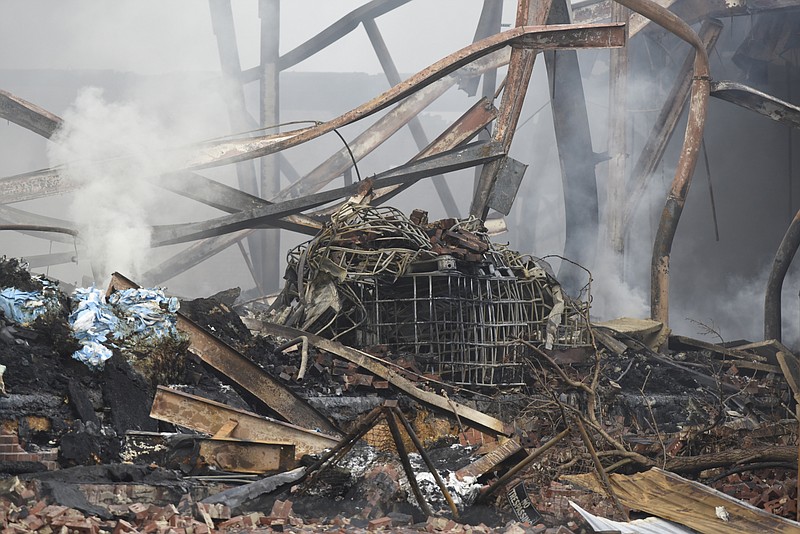Smoke continued to rise Monday from the fire at the former Barwick Mills facility in LaFayette, Ga., as emergency officials worked for a third day to extinguish the blaze that started there Saturday.
An investigation into environmental concerns there was hindered by the ongoing fire. And environmental concerns hampered the firefighting effort, officials said.
Questions
› What: Representatives from the Environmental Protection Agency and the City of LaFayette will be available today to answer the public’s questions about the Barwick Mills fire.› When: 3-7 p.m.› Where: LaFayette-Walker County Library, 305 South Duke St., LaFayette
LaFayette city manager David Hamilton said officials were trying to limit the amount of water used on the fire to reduce the impact of runoff to the Chattooga River, especially since officials aren't sure about potential contaminants. A portion of the burning building, once part of a carpet mill, was being used for storage. Something turned the water blue on Saturday, but whether that was carpet dye or something else has yet to be determined.
Drinking water locally is usually pulled from above the stream and from groundwater wells. As a precaution, the city switched to well water alone over the weekend.
Hamilton said it is unlikely drinking water would be affected, but wildlife in and around the waters might suffer from potential pollutants.
"We're working a balancing act between air quality and water quality for wildlife," Hamilton said.
As for the mystery blue hue, a vacuum truck was used to draw material from a site near the building that seems to be where the blue color was coming from, but "we are trying to look beyond that," Hamilton said. He said the true source of the cause of the hue could be elsewhere.
Some of the firefighting runoff is passing through the nearby wastewater treatment plant, Hamilton said.
Officials aren't sure how much impact the treatment plant is having on the runoff, but Hamilton chose to look on the bright side.
"It's better that it come through the treatment plant than to go directly into the stream," he said.
Hazardous material safety data sheets on some of the materials thought to be in the burned plant building were delivered to officials Monday afternoon, but Hamilton hadn't been able to look through them in detail. He said most of the materials appear to be various types of plastics and calcium carbonate.
Hamilton said the goal was to extinguish the blaze by nightfall Monday.
Carter Williamson, with the U.S. Environmental Protection Agency office in Atlanta, was at the scene all day Monday as officials strategized.
He said officials are watching the smoke plume from the fire as it swung Monday from the southwest to the southeast.
Williamson couldn't yet say what the "particulates" in the smoke were because there are so many different materials burning under the rubble.
Nearby Walker County school children, the elderly and residents with breathing problems were advised Monday to stay inside if the plume loomed overhead, he said.
More than 5,000 air samples have been collected to track the plume and its impact, Williamson said.
A roving monitor is being driven into the path of the plume to measure the amount of particulate matter in the smoke and determine whether levels are dropping, he said.
Crews will continue to work to contain runoff to the plant site, Williamson said, "so this stuff doesn't leach out from the mill into the tributaries."
"We are running 24/7 operations," Williamson said.
Meanwhile, officials will be on hand to try to better inform the public starting Tuesday, he said.
Some personnel will come from the Atlanta-based Agency for Toxic Substances and Disease Registry, a federal body that helps educate the public on health effects on humans, and answer questions about health concerns. The EPA is holding a meeting from 3-7 p.m. today at the LaFayette-Walker County Library, 305 South Duke St., to disseminate information and take questions.
More information on the impact of the fire will be coming in the days ahead, Williamson said.
"The problem with these old mills, they have been a variety of things," he said. "This thing was built in the 1880s or 1890s, and those folks are all gone. Sometimes stuff is left in basements or is stored because they didn't know what to do with it."
For now, the first priority is to put out the fire and contain the runoff while officials wait for more equipment to arrive over the next couple of days, he said.
"It's going as good as it can go for now," Williamson said.
Contact staff writer Ben Benton at bbenton@timesfreepress.com or twitter.com/BenBenton or www.facebook.com/ben.benton1 or 423-757-6569.
